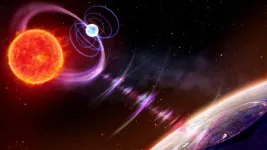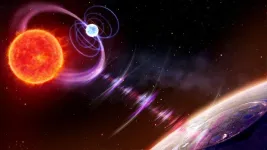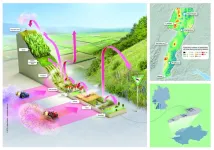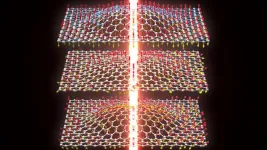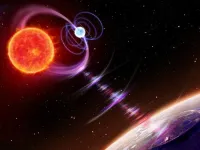(Press-News.org)
An international team of astronomers, including a Northwestern University astrophysicist, has traced a series of mysterious radio pulses to an unprecedented home.
Starting a decade ago, astronomers have detected a pulse of radio emission every two hours, coming from the direction of the Big Dipper. After combining observations from multiple telescopes, the team can now reveal the culprit: a binary system with a dead star.
According to the new study, a red dwarf and white dwarf are orbiting each other so tightly that their magnetic fields interact. Each time they bump together — which is every two hours — the interaction emits a long radio blast.
Although astronomers previously only traced long radio pulses to neutron stars, the new discovery shows the movement of stars within a binary system also can emit long-period radio bursts.
The study will be published on Wednesday (March 12) in the journal Nature Astronomy.
“There are several highly magnetized neutron stars, or magnetars, that are known to exhibit radio pulses with a period of a few seconds,” said Northwestern astrophysicist and study coauthor Charles Kilpatrick. “Some astrophysicists also have argued that sources might emit pulses at regular time intervals because they are spinning, so we only see the radio emission when source is rotated toward us. Now, we know at least some long-period radio transients come from binaries. We hope this motivates radio astronomers to localize new classes of sources that might arise from neutron star or magnetar binaries.”
Kilpatrick is a research assistant professor at Northwestern’s Center for Interdisciplinary Exploration and Research in Astrophysics. Iris de Ruiter, a postdoctoral scholar at the University of Sydney in Australia, led the study. At the time of the research, she was a Ph.D. student at the University of Amsterdam in the Netherlands.
Repeating radio signals
De Ruiter first discovered the pulses last year as she combed through archives from the Low Frequency Array(LOFAR), the largest radio telescope operating at the lowest frequencies that can be observed from Earth. Looking through the data, she found the first pulse appeared in 2015. When she subsequently sifted through more archival data from the same area of sky, de Ruiter discovered six more pulses.
Like a short flash of light — but in radio form — each pulse lasts anywhere from seconds to minutes in length. And, strangely, the pulses repeat at regular intervals, like a cosmic clock that ticks once every two hours. In recent years, astronomers have discovered more and more fast radio burst (FRBs). The radio pulses in question, however, are a much rarer event.
“The radio pulses are very similar to FRBs, but they each have different lengths,” Kilpatrick said. “The pulses have much lower energies than FRBs and usually last for several seconds, as opposed to FRBs which last milliseconds. There’s still a major question of whether there’s a continuum of objects between long-period radio transients and FRBs, or if they are distinct populations.”
Curious about the pulses’ sources, de Ruiter and her team obtained follow-up observations from the MMT Observatory in Arizona and the McDonald Observatory in Texas. Those observations revealed the source was not one flashing star — but two stars pulsing together. Located just 1,600 lightyears from Earth, the two stars orbit a common center of gravity, making a full revolution every 125.5 minutes.
The dead star dance
To confirm these findings, Kilpatrick used Northwestern’s remote access to the Multiple Mirror Telescope (MMT) in Arizona to observe the system during its full two-hour-long cycle. “Northwestern’s private access to the MMT enabled this science, which would not have been possible otherwise,” he said.
These observations allowed Kilpatrick to track variations in the system’s movement and gain optical spectra from the red dwarf. By taking light emitted from a star and splitting it into its component colors (or spectra), Kilpatrick was able to gain information about the star itself.
“The spectroscopic lines in these data allowed us to determine that the red dwarf is moving back and forth very rapidly with exactly the same two-hour period as the radio pulses,” Kilpatrick said. “That is convincing evidence that the red dwarf is in a binary system.”
The “back-and-forth” motion appeared to be from a companion star’s gravity pulling the red dwarf around. By precisely calculating the variation in these motions, Kilpatrick measured the mass of the much fainter companion. The calculated mass aligned with the typical mass of a white dwarf. While white dwarfs can range from low- to medium-mass, like our sun, red dwarfs are always much smaller and cooler.
“In almost every scenario, its mass and the fact that it is too faint to see means it must be a white dwarf,” Kilpatrick said. “This confirms the leading hypothesis for the white dwarf binary origin and is the first direct evidence we have for the progenitor systems of long-period radio transients.”
In the future, astronomers plan to study the ultraviolet emission of the binary source, dubbed ILTJ1101, in more detail. The findings could help determine the temperature of the white dwarf and reveal more about the history of white and red dwarfs.
“It was especially cool to add new pieces to the puzzle,” de Ruiter said. “We worked with experts from all kinds of astronomical disciplines. With different techniques and observations, we got a little closer to the solution step by step.”
The study, “A white dwarf binary showing sporadic radio pulses at the orbital period,” is based in part on data obtained with the International LOFAR Telescope (ILT), designed and constructed by ASTRON.
END
Researchers have developed a new process for sustainable lithium extraction, which could help to address the growing global demand for the metals used in electric vehicle batteries and renewable energy storage.
Current ways of getting lithium are bad for the environment and more sustainable approaches are hard to perform on a large scale, but scientists have developed new membranes to pull lithium directly out of salty lake water using electricity, leaving other metal ions behind.
Publishing their findings in Nature Water today (12 Mar), the international group of researchers from the UK, France, ...
An international team of astronomers led by Dr Iris de Ruiter, now at the University of Sydney, has shown that a white dwarf and a red dwarf star orbiting each other every two hours are emitting radio pulses.
Thanks to follow-up observations using optical and x-ray telescopes, the researchers were able to determine the origin of these pulses with certainty. The findings explain the source of such radio emissions found across the Milky Way galaxy for the first time.
The results are published in Nature Astronomy.
In recent years, better analysis techniques have given researchers the ability ...
A recent study by the RPTU University Kaiserslautern-Landau shows extensive pesticide contamination in the landscape of the Upper Rhine Region. The research team led by Carsten Brühl shows for the first time that synthetic chemical pesticides from conventional agriculture do not remain on the cultivated areas, but spread from the lowlands to the Black Forest and the Palatinate Forest. The results show that the entire landscape is contaminated with pesticide mixtures, shedding new light on the potential environmental ...
When water freezes into ice or boils into vapour, its properties change dramatically at specific temperatures. These so-called phase transitions are fundamental to understanding materials. But how do such transitions behave in nanomaterials? In Nature Communications, a team of scientists led by TU Delft (The Netherlands) presents new insights into the complex nature of phase transitions in magnetic nanomaterials. Their findings reveal the coupling between magnetic and mechanical properties, paving the way for ultra-sensitive sensors.
The scientists from TU Delft, together with colleagues from the University of Valencia and the National University of Singapore, studied ...
(Images available via the links in the Notes section) An international team of astrophysicists led by the Netherlands and the UK have discovered that radio pulses lasting seconds to minutes are due to two stars coming together – rather than emissions from a single star. The results are published today (12 March) in Nature Astronomy.
In recent years, a new astronomical phenomenon has puzzled radio astronomers: researchers have detected radio pulses from the Milky Way that last from seconds to minutes. These pulses are unlike anything expected from known radio-emitting neutron stars, or pulsars*, ...
Research Highlights:
A sedentary lifestyle such as watching TV (two or more hours daily) may be a key factor in the risk of developing heart and blood vessel diseases, according to an analysis of health records from a large U.K. biomedical database.
People with higher genetic risk for Type 2 diabetes may be more likely to have a heart attack, stroke or other types of atherosclerotic cardiovascular disease. However, limiting TV watching to no more than one hour a day may help offset the increased risk of these ...
Results indicate the closer the Doomsday Clock ticks to midnight, the higher the rates are for mortality specific to Alzheimer’s disease, suicide, unintentional injuries, alcohol and substance-related disorders
Since 1947, the Bulletin of the Atomic Scientists (BAS) has used the metaphor of the Doomsday Clock as a means of communicating how close the human species is to self-imposed annihilation, represented as midnight. While early iterations of the clock focused more exclusively on the dangers of nuclear weapons, the BAS has also begun to consider other evolving existential dangers ...
Second-hand electric cars may be close to a “tipping point” where they become more popular than equivalent petrol and diesel cars in the UK, new research shows.
Researchers analysed data from car sales website Auto Trader, comparing daily views of adverts for electric vehicles (EVs) with petrol/diesel cars.
Interest in second-hand EVs grew rapidly, doubling from 3.5% of advert views in 2022 to 7% in 2023.
Importantly, interest in EVs became more “sticky”. Events such as petrol price increases drove extra EV views – and over time these spikes of attention lasted longer and longer.
“To identify ...
A new study revealed significant differences in the appearance and behaviour of the two one-horned Asiatic rhinoceros species, challenging long-standing classifications and supporting a re-evaluation of their status.
The study, led by zoologist Francesco Nardelli and paleontologist Kurt Heißig, highlights how millions of years of evolutionary pressures have shaped the distinct adaptations of the Indian (Rhinoceros unicornis) and Sundaic (Rhinoceros sondaicus) rhinoceroses. The critically endangered Sundaic rhinoceros has a slender skull, a broader and lower back of the head, and a shorter nose and teeth suited for browsing leaves. In contrast, the ...
Most people are familiar with loopholes. When your boss, landlord, partner, customer, or government asks you to do something you don’t want to do, and yet you can’t say “no,” you may resort to malicious compliance – doing what someone asked, but not actually what they meant. Most parents are probably familiar with such “little lawyer” behavior too: if a parent says, “Time to put the tablet down,” a child might physically put the tablet down on the table – and then keep playing on it. While such ...
